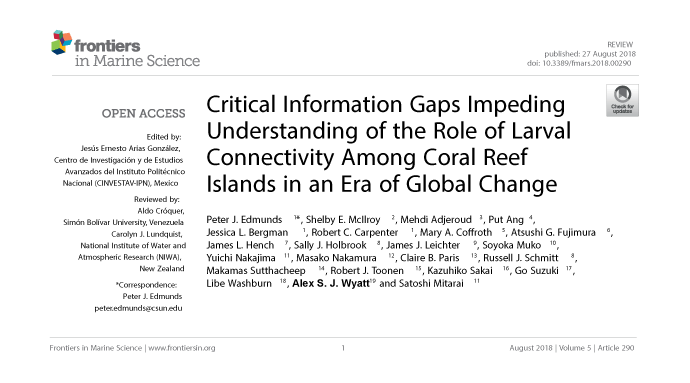Critical information gaps impeding understanding of the role of larval connectivity among coral reef islands in an era of global change
Peter J. Edmunds1*, Shelby E. McIlroy2, Mehdi Adjeroud3, Put Ang4, Jessica L. Bergman1, Robert C. Carpenter1, Mary Alice Coffroth5, Atsushi Fujimura6, James Hench7, Sally J. Holbrook8, James J. Leichter9, Soyuko Muko10, Yuichi Nakajima11, Massako Nakamura12, Claire B. Paris13, Russell Schmitt8, Makamas Sutthacheep14, Robert Toonen15, Kazuhiko Sakai16, Go Suzuki17, Libe Washburn8, Alex S. Wyatt18 and Satoshi Mitarai11
1California State University, Northridge, United States, 2Swire Institute of Marine Science, University of Hong Kong, Hong Kong, 3Institut de recherche pour le développement (IRD), France, 4The Chinese University of Hong Kong, Hong Kong, 5University at Buffalo, United States, 6University of Guam, United States, 7Duke University, United States, 8University of California, Santa Barbara, United States, 9Scripps Institution of Oceanography, University of California, San Diego, United States, 10Nagasaki University, Japan, 11Okinawa Institute of Science and Technology, Japan, 12School of Marine Science and Technology, Tokai University, Japan, 13Rosenstiel School of Marine and Atmospheric Science, University of Miami, United States, 14Ramkhamhaeng University, Thailand, 15Hawaii Institute of Marine Biology, University of Hawaii at Manoa, United States, 16Sesoko Station, Japan, 17Seikai National Fisheries Research Institute, Japan, 18Atmosphere and Ocean Research Institute, University of Tokyo, Japan
Populations of marine organisms on coral reef islands (CRI) are connected in space and time by seawater that transports propagules of plants, animals, and algae. Yet, despite this reality, it is often assumed that routine replenishment of populations of marine organisms on CRI is supported by locally-sourced propagules (hereafter, larvae). Following large disturbances, however, distantly-sourced larvae from less disturbed CRI within a regional meta-population are likely to be important for local population recovery, but evaluating the roles of locally- versus distantly- sourced larvae remains difficult. While larval sources are relatively well known for many fishes, they remain virtually unknown for most taxa, particularly those associated with the benthos, including hermatypic corals. We make the case that CRI provide natural laboratories in which studies of connectivity can enhance understanding of community dynamics under future disturbance regimes, especially where ongoing changes have created novel systems that are functioning in ways differing from the recent past. However, this potential cannot be realized due to the limited breadth, detail, and spatio-temporal concordance of exiting research. Targeted research on the role of connectivity in mediating ecosystem resilience of CRI is required to understand how populations of marine organisms will change in a future affected by large-scale disturbances of anthropogenic origin. Using the coral reefs of Mo’orea (French Polynesia), Okinawa (Japan), and St. John (US Virgin Islands) as examples, we describe the data required to achieve this objective, and discuss why provision of these data will require new modes of multidisciplinary and collaborative research.

